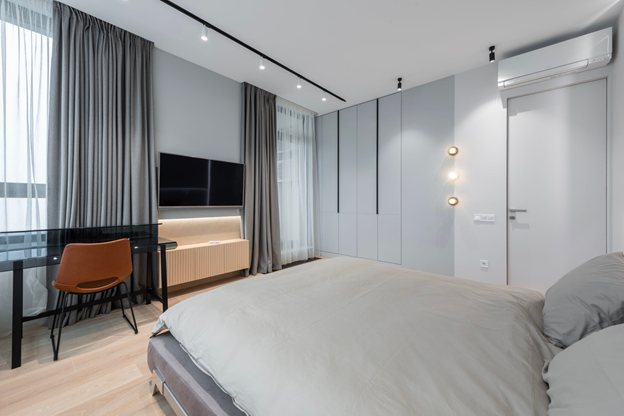
Creating a home that’s both kid-friendly and stylish is often seen as an impossible feat. The notion of a living space that accommodates the demands of children—messy toys, sticky fingers, and the need for constant supervision—can seem incompatible with high-end design and refined aesthetics. However, with thoughtful planning and design, it’s entirely possible to have a home that strikes a harmonious balance between practicality and beauty.
In this article, we’ll explore how to design a home that caters to the needs of young ones while maintaining an elegant and stylish atmosphere. From choosing durable materials to embracing multifunctional furniture, here’s how to achieve a home that is as beautiful as it is functional.
1. Opt for Durable and Low-Maintenance Materials
When designing a kid-friendly home, choosing the right materials is key to achieving both style and practicality. Kids tend to be tough on surfaces, so opting for materials that are both durable and easy to clean will help preserve the longevity of your furniture and finishes.
Flooring: Functional and Chic
-
Hardwood or Laminate Flooring: Hardwood floors exude timeless elegance, but they can be prone to scratches. Laminate or engineered wood offers a more budget-friendly alternative that still retains the look of natural wood while being easier to maintain. Both options are durable, easy to clean, and look sophisticated in any room.
-
Rugs with Washable Covers: A stylish area rug can transform a room, but it’s essential to choose one with a washable or stain-resistant cover. Go for rugs in neutral tones or classic patterns like stripes or geometric designs to add flair while keeping things practical.
-
Vinyl or Cork Flooring: For high-traffic areas, vinyl and cork floors are excellent choices. Both materials are soft underfoot, which reduces the likelihood of injuries, while cork is also naturally anti-microbial—making it perfect for homes with young children.
Fabrics: Family-Friendly and Beautiful
-
Performance Fabrics: Choose upholstered furniture with performance fabrics such as Sunbrella, Crypton, or velvet blends. These fabrics are resistant to stains, fading, and wear, making them perfect for homes where children play and lounge.
-
Leather Furniture: For a sleek and luxurious look, leather sofas and chairs provide durability and ease of cleaning. Leather ages beautifully, and any marks or scratches only add to the character, making it a smart choice for both style and practicality.
-
Slipcovers: If you prefer the look of fabric, slipcovers are a game-changer. Not only are they easy to wash and replace, but they also allow you to update your style without investing in new furniture every few years.
2. Design Kid-Friendly Zones Within the Home
Instead of trying to make every corner of the home kid-friendly, consider creating designated areas for play, study, and rest. This will allow you to maintain a stylish aesthetic in more formal spaces, while ensuring that your children have a safe, functional environment to thrive in.
Living Room: Style Meets Function
-
Stylish, Yet Practical Furniture: Invest in elegant, sturdy furniture that can withstand the rough and tumble of daily life. Opt for coffee tables and side tables with rounded edges, which are safer for small children. You can also use decorative baskets or ottomans that double as storage to keep toys, books, and games hidden but easily accessible.
-
Open-Plan Layout: Embrace an open-plan layout, where the living room is part of a larger, connected space that flows into the kitchen or dining room. This not only makes it easier to supervise kids but also fosters a sense of togetherness while maintaining an airy, minimalist aesthetic.
Playroom: Creative and Colorful
-
Bright, Fun Accents: While you want your playroom to be stylish, it should also invite creativity. Consider painting the walls in muted tones of blue, green, or yellow, and introduce fun, yet tasteful, accessories—such as woven baskets, decorative shelves, or a statement light fixture. A large play mat with educational patterns can also add a playful touch without overwhelming the room.
-
Modular Storage Solutions: In a playroom, storage is essential for keeping the space organized and stylish. Opt for modular storage units or shelving systems that can easily evolve as your children grow. Look for elegant storage bins or baskets that blend seamlessly with the overall décor.
Bedrooms: Peaceful and Practical
-
Functional Furniture: Invest in high-quality, durable furniture that can serve your child well into their teenage years. For example, consider a bed with built-in storage or a desk that can transition from a play area to a study zone. Choose neutral-coloured furniture that can be easily dressed up with colourful throws, pillows, and rugs.
-
Soft Lighting: Add a calming atmosphere to your child’s room with ambient lighting. Opt for sleek bedside lamps, pendant lights, or string lights that can provide a warm glow without overwhelming the space. You can mix in soft-toned rugs and curtains that enhance the cosy, tranquil feel.
3. Incorporate Multitasking, Space-Saving Furniture
Families with young children often have limited space. To make the most of your home, consider investing in multifunctional furniture pieces that serve multiple purposes while maintaining a stylish look.
Bunk Beds and Lofted Beds
-
Space Optimization: Bunk beds or lofted beds are an excellent way to save space in a child’s room. The area underneath a lofted bed can be used for a desk, a reading nook, or additional storage.
-
Stylish Designs: Choose sleek, modern designs with clean lines and minimalistic hardware. Avoid overly decorative bunk beds that might clash with the room’s overall design.
Storage Solutions
-
Built-In Storage: Opt for built-in cabinetry or shelving to reduce clutter. This not only makes the space more organized but also maintains a chic, uncluttered look.
-
Storage Ottomans: Choose storage ottomans that double as seating, making them perfect for the living room or playroom. These items can house toys, blankets, or extra cushions while blending seamlessly into the décor.
Convertible Furniture
-
Convertible Sofas: In smaller homes or apartments, a sofa that transforms into a bed can be a real lifesaver. Choose sleek, modern designs that don’t sacrifice comfort for function.
-
Fold-Out Desks or Tables: In spaces where kids may need a study area, fold-out desks or tables are an excellent solution. They can be tucked away when not in use, allowing you to maintain a stylish, uncluttered space.
4. Add Personal Touches That Reflect Family Life
While maintaining style, don’t forget to incorporate personal touches that make the space feel like home. Personalized elements can make a home more welcoming and create a space that feels truly yours.
Art and Photographs
-
Framed Family Photos: Create a gallery wall of family portraits or kids’ artwork. Framing their artwork adds a personal and sophisticated touch to any room, while also celebrating your child’s creativity.
-
Custom Wall Décor: Consider custom wall decals or wall art that reflect your family’s interests, whether it’s nature, travel, or hobbies. Choose designs that can grow with your children as they get older.
Interactive Décor
-
Chalkboard Walls: In a playroom or even a hallway, a chalkboard wall offers a creative outlet for kids. It’s functional and fun, allowing them to express themselves while still looking stylish.
-
Interactive Furniture: Choose furniture pieces that children can personalize, like a play table with interchangeable surfaces or a modular sofa system that allows them to move and create their own configurations.
Conclusion
Designing a kid-friendly yet stylish home doesn’t have to be an either-or situation. By incorporating durable materials, creating distinct zones for play and relaxation, and investing in space-saving, multifunctional furniture, you can create a living environment that is both practical and beautiful. Through thoughtful choices in colour, furniture, and design, you can achieve a space where children feel comfortable, safe, and inspired—while still maintaining an elegant, cohesive aesthetic that suits your personal style. With these strategies in mind, your home can be a welcoming, stylish sanctuary for both you and your little ones.
For more information, follow below useful resources-
- Whether you’re planning a remodel or just improving day-to-day comfort, 247 Homes Care shares smart home maintenance tips, cleaning hacks, and seasonal checklists. It’s a reliable guide for homeowners who want to protect their investment and make daily life more efficient.
- From decor inspiration to DIY home hacks, A2Z Home Blog is packed with ideas to beautify your space. Whether you’re a minimalist or a maximalist, you’ll find room-by-room advice and product recommendations that suit every budget and style.
- If sustainability is a priority for your living space, Eco Hive Homes delivers green solutions. The blog explores eco-conscious renovations, energy-saving tips, and natural design ideas for homeowners who want their spaces to be as earth-friendly as they are beautiful.
- Bring elegance and warmth to your home with interior ideas from Glory Homey. From soft furnishings to layout planning, this blog focuses on creating luxurious yet liveable homes that blend comfort and class seamlessly.
- Your home should reflect your aura — and Home Aaura helps you achieve just that. With content on lighting, textures, and colour theory, the blog teaches how to infuse personal energy into every corner of your home.
- Design your dream space with expert guidance from Home Dezins. From modern makeovers to budget-friendly room refreshes, this blog provides stylish, practical solutions for homeowners seeking high-impact visual upgrades.
- No matter the size of the project, Home Ez Fix offers repair tips, appliance care advice, and step-by-step DIY fixes to keep your home running smoothly. It’s perfect for homeowners who prefer doing things themselves without calling in a pro every time.
- Family life and home living go hand in hand at Home Family Inc. The blog combines parenting advice, household management, and interior style tips to help you create a nurturing environment for the entire family.
- Looking for the perfect property or planning your next move? Home Findrs shares tips on home hunting, market trends, and relocation strategies, making it a helpful resource for both first-time buyers and seasoned homeowners.
- From welcoming entryways to functional kitchens, Home Hallo guides you through transforming your space into a home that feels alive. It’s full of small, thoughtful upgrades that have a big emotional and visual impact.
- If high-end living speaks to you, Home Luxe Livings offers aspirational interior ideas, luxury finishes, and modern design philosophies. It’s a curated space for those looking to elevate their home’s aesthetic with elegance and sophistication.
- Planning your next renovation project? Home Ranovation covers everything from budgeting and permits to style guides and before-after inspiration. Whether it’s your bathroom, kitchen, or entire house, this blog keeps your remodel on track and stress-free.
- Create a space you love to live in with help from Homes Amore. This blog focuses on heartfelt decor, functional organisation, and cosy atmospheres that make every room feel personal and inviting.
- For homeowners seeking 360-degree guidance, Homez 360 delivers tips across decor, maintenance, smart home tech, and lifestyle. It’s a practical yet stylish blog that helps you manage your home inside and out.
- Add bold flair and modern creativity to your interiors with Houzzz Decor. With room-by-room decor ideas, seasonal styling tips, and DIY tricks, the blog inspires readers to turn basic spaces into beautiful statements.
- If you’re passionate about interiors and timeless design, Interior Dezin is your source for aesthetic inspiration. The blog features curated room ideas, colour palettes, furniture layout tips, and design principles that help homeowners turn every room into a refined and harmonious space.
- Transform your everyday living experience with smart decor and home hacks from Live Homee. This blog delivers tips on comfort-enhancing upgrades, lighting, space-saving tricks, and style advice for anyone looking to create a welcoming and personalised home.
- For practical lifestyle content mixed with home inspiration, My Home Lyf is a refreshing read. Whether you’re decorating a nursery, updating the living room, or creating a more functional kitchen, it offers ideas that are both stylish and family-friendly.
- Make every corner of your home shine with expert ideas from Nova Home Decor. This blog showcases modern aesthetics, organisation tips, and decor hacks designed to balance beauty with practicality — perfect for homeowners who love transforming spaces.
- Whether you’re designing your forever home or upgrading a rental, Oasis Home Life inspires comfortable, peaceful living. The blog explores design psychology, soft styling techniques, and spatial flow — helping you craft a home that truly feels like a sanctuary.
- Moving into a new space or updating an old one? Ox My Home offers smart advice on budget decor, room planning, and functional improvements. It’s a handy destination for anyone looking to personalise their space with creativity and confidence.
- Feel secure and stylish with tips from Secure Homes Now. This blog combines home security essentials with aesthetic upgrades — showing how to safeguard your home while improving its look and value with thoughtful additions and reliable technology.
- Balance function and beauty with practical inspiration from Star Home Esential. The blog covers storage solutions, multi-use furniture, and affordable makeover ideas — ideal for busy households looking to enhance their home’s comfort without breaking the bank.
- From weekend DIY projects to seasonal decorating themes, TJ Home Blog delivers rich content for creative homeowners. It’s packed with inspiring visuals, trend breakdowns, and step-by-step tutorials that help turn your Pinterest boards into real-life results.
- Give your home the care it deserves with thoughtful articles from TMR Home. Whether it’s plumbing, flooring, garden layout, or wall decor, this blog equips you with the knowledge to make functional and stylish choices for long-term home value.
- Looking to enhance your property inside and out? WWW Home Improvements features DIY repair tips, energy-saving ideas, and layout guides to improve curb appeal and indoor comfort. It’s a helpful resource for hands-on homeowners and first-time renovators alike.
- For all things repair, upgrade, and remodel, Reddy Home Pros is a trusted name. The blog combines expert-level advice with budget-conscious tips to help you tackle big and small home projects with clarity, safety, and efficiency in mind.
- No more waiting for a handyman — Mr Fix Homes empowers homeowners with how-to guides, tool reviews, and project walkthroughs. It’s perfect for those who want to take control of their repairs and upgrades confidently and cost-effectively.
- Stay updated with the latest home trends, decor innovations, and lifestyle improvements with Homes Herald. This blog serves as a hub for interior design lovers and savvy homeowners looking to refine their personal space with intention and taste.
- Get inspired by nature, minimalism, and timeless design with Home Things NW. The blog focuses on creating warmth, order, and beauty using natural materials, clever layouts, and home organisation tools for peaceful, uncluttered living.





